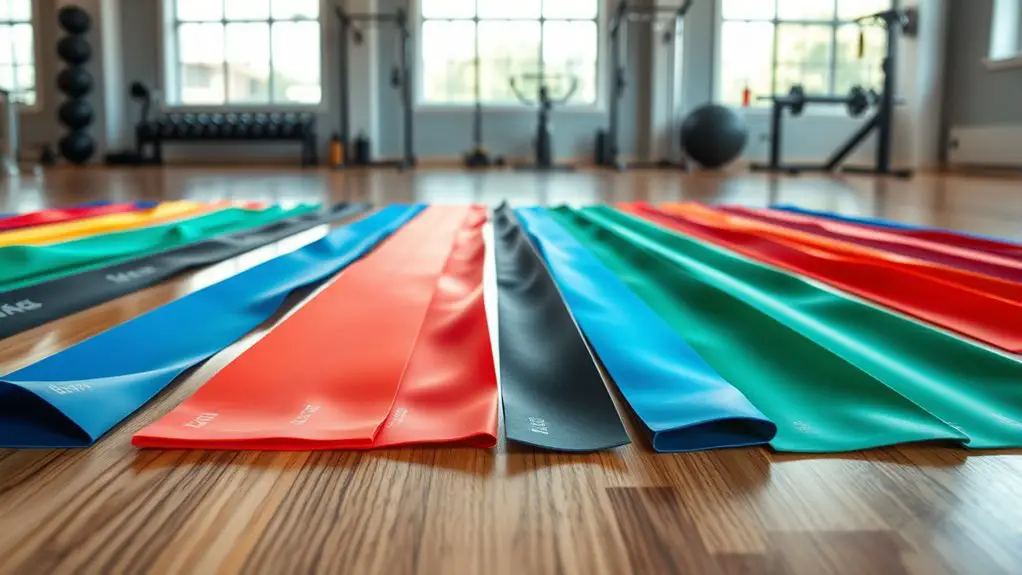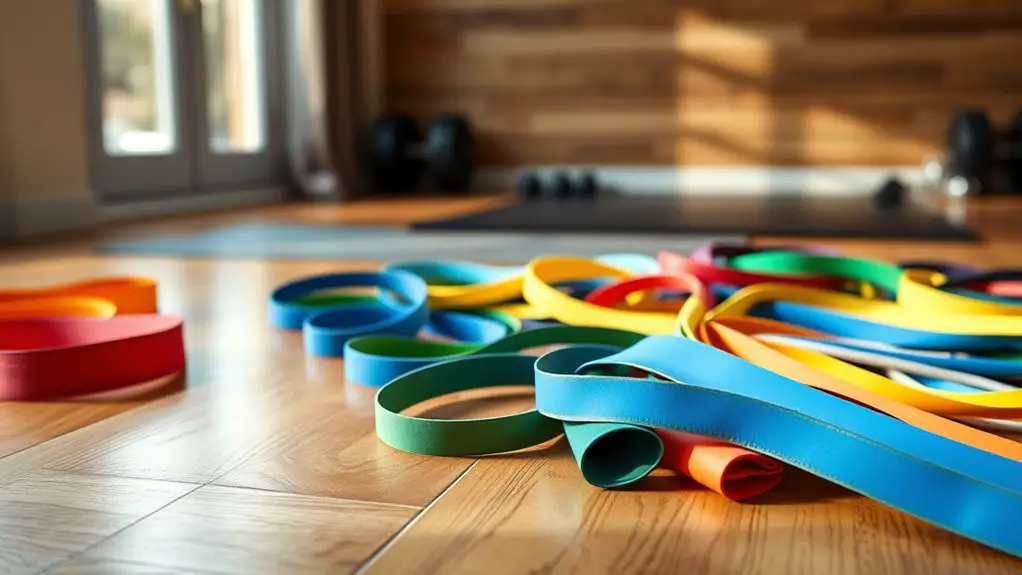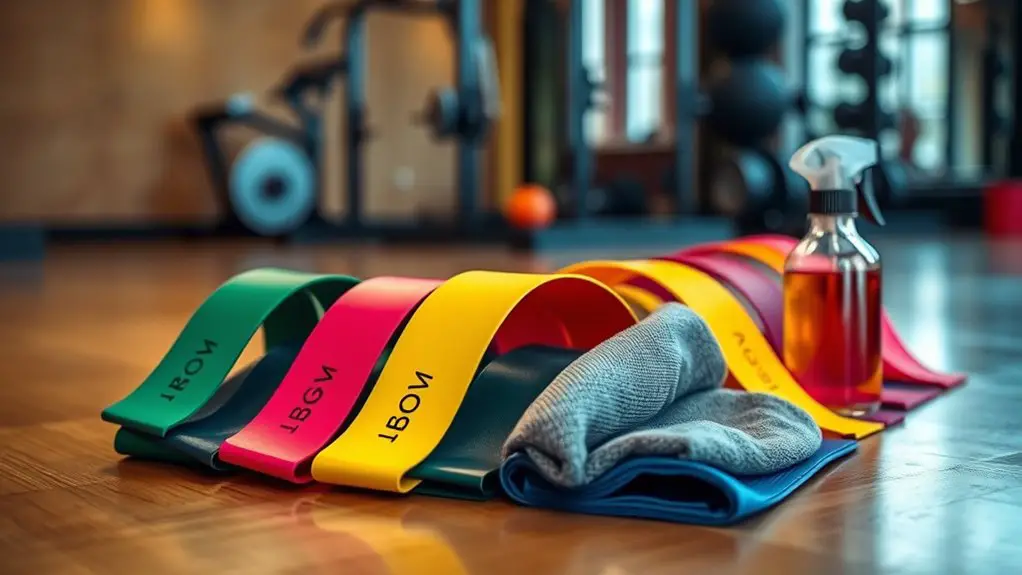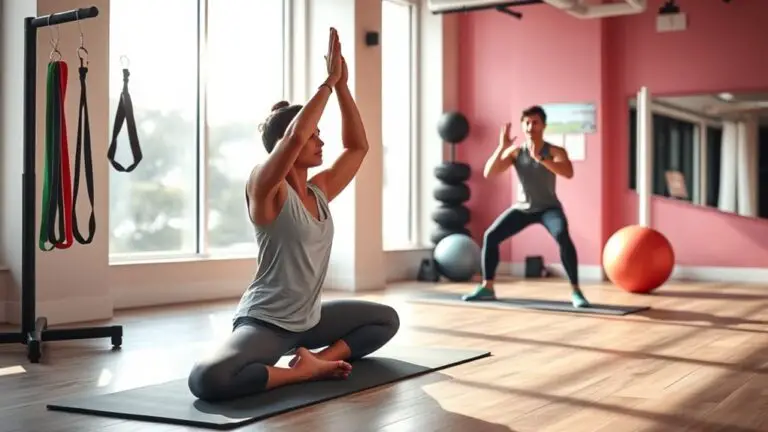How to Choose the Right Resistance Bands for Gym Workouts

To choose the right resistance bands for your gym workouts, start by evaluating your fitness level and defining your goals. Beginners should opt for lighter bands, while experienced users might need heavier options. Consider the type of band that fits your needs—loop, tube, or fabric. Also, check the material for durability and elasticity. Finally, maintain your bands properly to extend their lifespan. With these tips, you’ll be better equipped to enhance your training. Explore further for more insights!
Understanding Resistance Band Types

When it comes to resistance bands, knowing the different types can make all the difference in your workouts. Resistance bands come in various band colors, each representing a specific resistance level. Typically, lighter colors like yellow or green indicate lower resistance, while darker shades such as blue or black suggest higher resistance.
Understanding these levels helps you choose the right band for your fitness goals. For beginners, starting with lighter bands can build strength and confidence. As you progress, shifting to bands with higher resistance levels can challenge your muscles and enhance your workout.
You might also encounter loop bands, tube bands, and fabric bands, each serving unique purposes. Loop bands are great for enhancing glute strength, while tube bands often come with handles for versatile exercises. By selecting the right type and resistance level, you can maximize your workout effectiveness and achieve your fitness goals more efficiently.
Assessing Your Fitness Level
How do you know which resistance band is right for you? The first step is evaluating your fitness level. Begin with fitness assessments to gauge your strength and endurance. Consider your experience with resistance training—if you’re a beginner, lighter bands will be more suitable, while seasoned athletes may require heavier options.
Next, think about how you plan to use the bands. Are you focusing on strength exercises, flexibility, or rehabilitation? Each goal might require different resistance levels.
Don’t forget about progress tracking. As you improve, you’ll want to gradually increase resistance to continue challenging your muscles. This guarantees that you’re not only using the right band for now but also setting yourself up for future growth. By understanding your current abilities and how you plan to evolve, you can choose resistance bands that’ll effectively support your fitness journey.
Setting Workout Goals

Setting clear workout goals is essential for your fitness journey. Start by defining what you want to achieve, taking into account your current fitness level and the resistance range that suits you best. This will help you choose the right resistance bands and create a more effective workout plan.
Define Fitness Objectives
To achieve your fitness goals effectively, it is crucial to define your objectives before diving into workouts. This not only keeps your fitness motivation high but also helps you incorporate workout variety. Consider what you want to accomplish—losing weight, building muscle, or increasing endurance. Set specific, measurable goals to track your progress.
Here’s a simple table to help you visualize your objectives:
| Objective | Example Goal |
|---|---|
| Weight Loss | Lose 10 pounds in 3 months |
| Muscle Gain | Increase bench press by 20 lbs in 2 months |
| Endurance | Run 5K in under 30 minutes |
| Flexibility | Touch toes within 4 weeks |
Assess Current Fitness Level
After you’ve defined your fitness objectives, the next step is evaluating your current fitness level. Understanding where you stand is essential for setting achievable goals and choosing the right resistance bands. You can perform simple fitness assessments to gauge your strength and endurance, especially if you’re at beginner levels. Here are three key areas to take into account:
- Strength: Test your ability to lift weights or perform bodyweight exercises.
- Endurance: Evaluate how long you can maintain an exercise, like planking or running.
- Flexibility: Assess your range of motion through simple stretches.
Consider Desired Resistance Range
How do you determine the right resistance for your workouts? Start by considering your fitness goals and desired resistance levels. If you’re aiming to build strength, you’ll want bands that offer higher resistance. For endurance training, lighter bands might be more suitable. It’s essential to choose bands that allow for progressive training, meaning you can gradually increase resistance as you get stronger. This approach not only helps prevent plateaus but also keeps your workouts challenging and effective. Remember, the right resistance should make exercises feel tough but manageable. Test different bands to find the perfect fit, ensuring they support your goals while providing the versatility needed for various exercises. Your journey to fitness becomes more rewarding with the right resistance!
Evaluating Band Material and Durability

When you’re selecting resistance bands for your gym workouts, evaluating the material and durability is essential, especially since these factors directly impact performance and longevity. To help you make an informed decision, consider the following:
- Material Quality: Look for bands made from high-quality latex or rubber, as these materials tend to offer better band elasticity and resilience compared to cheaper alternatives.
- Durability: Check for signs of wear and tear, like fraying or cracks. A durable band can withstand frequent use, ensuring you get the most out of your investment.
- Tension Testing: Stretch the band to see how it recovers. A good resistance band should return to its original shape without losing elasticity, indicating a longer lifespan.
Considering Band Sizes and Lengths
While you might think that any resistance band will do, considering the sizes and lengths available can greatly affect your workout experience. Band width considerations are essential, as wider bands provide more stability during exercises, while narrower bands focus on targeted muscle engagement. Choosing lengths also plays a significant role; shorter bands are great for specific movements, while longer bands offer versatility for various exercises.
Here’s a quick reference table to help you visualize:
| Band Width | Suggested Length | Best For | Resistance Level | Common Exercises |
|---|---|---|---|---|
| 0.5 inch | 4 feet | Isolation movements | Light | Bicep curls |
| 1 inch | 5 feet | Full-body workouts | Medium | Squats |
| 1.5 inches | 6 feet | Compound exercises | Heavy | Deadlifts |
| 2 inches | 7 feet | Strong resistance needed | Very Heavy | Chest presses |
| 3 inches | 8 feet | Advanced training | Extreme | Olympic lifts |
Make sure you choose wisely!
Tips for Maintenance and Care

Proper maintenance and care of your resistance bands can considerably extend their lifespan and keep them performing at their best. By implementing a few simple practices, you can guarantee your bands remain in top shape. Here are some effective tips:
- Cleaning Techniques: Wipe down your bands with a damp cloth after each use to remove sweat and dirt. Occasionally, use mild soap and water for a deeper clean, then dry thoroughly.
- Storage Solutions: Avoid leaving your bands in direct sunlight or extreme temperatures, as this can weaken the material. Instead, store them in a cool, dry place, preferably in a pouch or basket to prevent tangling.
- Regular Inspections: Check your bands regularly for any signs of wear or damage. If you notice any tears or cracks, replace them to avoid injury.
Following these tips will help keep your resistance bands in great condition!
Frequently Asked Questions
Can Resistance Bands Replace Free Weights Entirely?
Resistance bands can’t completely replace free weights, but they offer great band versatility and effective weight alternatives. You can target various muscle groups and enhance your workout routine with bands, especially for rehabilitation or mobility training. However, free weights provide unique benefits, like stabilizing muscles and allowing for heavier lifts. It’s best to incorporate both into your regimen, so you can enjoy the strengths of each type of training.
How Do I Incorporate Resistance Bands Into Cardio Workouts?
To incorporate resistance bands into your cardio workouts, start by choosing the right band intensity for your fitness level. You can add bands to exercises like jumping jacks or squats, enhancing resistance while keeping your heart rate up. Mixing in band-assisted moves provides cardio variety, making your sessions more dynamic and engaging. Experiment with different exercises, and you’ll find that bands can elevate your cardio routine effectively and enjoyable.
Are Resistance Bands Suitable for Rehabilitation Exercises?
Absolutely, resistance bands are great for rehabilitation exercises! They offer numerous rehabilitation benefits, such as improving strength and flexibility while minimizing strain on your joints. You can use resistance band exercises to target specific muscle groups, making your recovery process more effective. Plus, their versatility allows you to adjust resistance levels easily, catering to your needs as you progress. So, if you’re recovering from an injury, incorporating bands into your routine can be a smart choice!
Can I Use Resistance Bands for Stretching Routines?
Think of resistance bands as the strings of a finely tuned instrument, ready to enhance your stretching routine. You can definitely use them for stretching, and they’ll provide multiple benefits, like improved flexibility and muscle activation. When choosing band types, opt for lighter resistance bands for gentle stretches and heavier ones for deeper engagement. Incorporating them into your routine can amplify your stretching benefits, making each session more effective and enjoyable.
How Do I Choose Bands for Group Workouts?
When choosing bands for group workouts, consider band color selection, as different colors usually indicate varying resistance levels. Make certain everyone in your group can find the right fit. Additionally, band material considerations are essential; look for durable, high-quality materials that can withstand intense use. Opt for latex or fabric bands based on comfort and the type of exercises you’ll be doing. This guarantees everyone can participate safely and effectively in your sessions.





